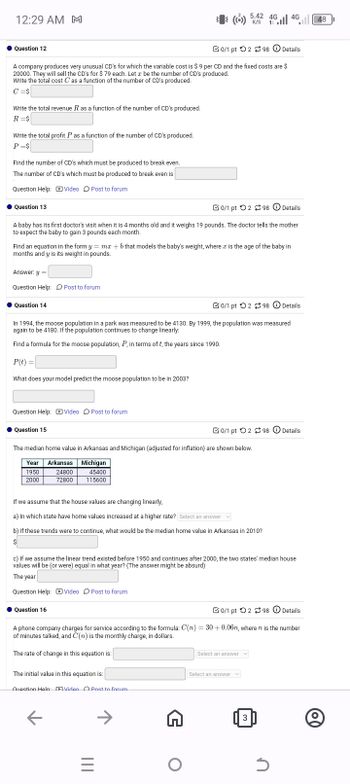
Micro Economics For Today
10th Edition
ISBN: 9781337613064
Author: Tucker, Irvin B.
Publisher: Cengage,
expand_more
expand_more
format_list_bulleted
Question
Up

Transcribed Image Text:12:29 AM M
4G
5.42 46 46 48
(4) 5.42 46
K/S 1
Question 12
0/1 pt 298
Details
A company produces very unusual CD's for which the variable cost is $9 per CD and the fixed costs are $
20000. They will sell the CD's for $ 79 each. Let a be the number of CD's produced.
Write the total cost C as a function of the number of CD's produced.
C=$
Write the total revenue R as a function of the number of CD's produced.
R=$
Write the total profit P as a function of the number of CD's produced.
P=$
Find the number of CD's which must be produced to break even.
The number of CD's which must be produced to break even is
Question Help: Video Post to forum
Question 13
0/1 pt 298 Details
A baby has its first doctor's visit when it is 4 months old and it weighs 19 pounds. The doctor tells the mother
to expect the baby to gain 3 pounds each month.
Find an equation in the form y = mx + b that models the baby's weight, where a is the age of the baby in
months and y is its weight in pounds.
Answer: y =
Question Help: Post to forum
Question 14
0/1 pt 298 Details
In 1994, the moose population in a park was measured to be 4130. By 1999, the population was measured
again to be 4180. If the population continues to change linearly:
Find a formula for the moose population, P, in terms of t, the years since 1990.
P(t) =
What does your model predict the moose population to be in 2003?
Question Help: Video Post to forum
Question 15
0/1 pt 298 Details
The median home value in Arkansas and Michigan (adjusted for inflation) are shown below.
Year Arkansas
Michigan
1950
2000
24800
72800
45400
115600
If we assume that the house values are changing linearly,
a) In which state have home values increased at a higher rate? Select an answer
b) If these trends were to continue, what would be the median home value in Arkansas in 2010?
$
c) If we assume the linear trend existed before 1950 and continues after 2000, the two states' median house
values will be (or were) equal in what year? (The answer might be absurd)
The year
Question Help: Video Post to forum
Question 16
0/1 pt 298 Details
A phone company charges for service according to the formula: C(n) = 30+ 0.06n, where n is the number
of minutes talked, and C(n) is the monthly charge, in dollars.
The rate of change in this equation is:
Select an answer
The initial value in this equation is:
Question Help Video Post to forum
K
→
=
|||
Select an answer
3
Expert Solution
This question has been solved!
Explore an expertly crafted, step-by-step solution for a thorough understanding of key concepts.
Step by stepSolved in 2 steps

Knowledge Booster
Similar questions
- Which costs are measured on per-unit basis: fixed costs, average cost, avenge variable cost, variable costs, and marginal cost?arrow_forwardDo you think that the taxicab industry in large cities would be subject to significant economies of scale? Why or why not?arrow_forwardWhat shapes would you generally expect each of the following cost curves to have: fixed costs, variable costs, marginal costs, average total costs, and average variable costs?arrow_forward
- How does fixed cost affect marginal cost? Why is this relationship important?arrow_forwardWhat are explicit and implicit costs?arrow_forwardAverage cost curves (except for avenge fixed cost) tend to be U-shaped, decreasing and then increasing. Marginal cost curves have the same shape, though this may be harder to see since most of the marginal cost curve is increasing. Why do you think that average and marginal cost curves have the same general shape?arrow_forward
- Compute the average total cost, average variable cost, and marginal cost of producing 50 and 72 haircuts. Draw the graph of line three curves between 60 and 72 haircuts.arrow_forwardWhat shape of a long-run average cost curve illustrates economies of scale, constant returns to scale, and diseconomies of scale?arrow_forwardA common name for fixed cost is overhead. If you divide fixed cost by the quantity of output produced, you get average fixed cost. Supposed fixed cost is 1,000. What does the average fixed cost curve look like? Use your response to explain what spreading the overhead means.arrow_forward
- What is the difference between fixed costs and variable costs?arrow_forwardReturn to Figure 7.7. What is the marginal gain in output from increasing the number of batters from 4 to 5 and from 5 to 6? Does it continue the pattern of diminishing marginal returns? Figure 7.7 How output Affects Total costsarrow_forwardHow do we calculate each of the following: marginal cost, average total cost, and average variable cost?arrow_forward
arrow_back_ios
SEE MORE QUESTIONS
arrow_forward_ios
Recommended textbooks for you


 Economics (MindTap Course List)EconomicsISBN:9781337617383Author:Roger A. ArnoldPublisher:Cengage Learning
Economics (MindTap Course List)EconomicsISBN:9781337617383Author:Roger A. ArnoldPublisher:Cengage Learning
 Managerial Economics: Applications, Strategies an...EconomicsISBN:9781305506381Author:James R. McGuigan, R. Charles Moyer, Frederick H.deB. HarrisPublisher:Cengage Learning
Managerial Economics: Applications, Strategies an...EconomicsISBN:9781305506381Author:James R. McGuigan, R. Charles Moyer, Frederick H.deB. HarrisPublisher:Cengage Learning Managerial Economics: A Problem Solving ApproachEconomicsISBN:9781337106665Author:Luke M. Froeb, Brian T. McCann, Michael R. Ward, Mike ShorPublisher:Cengage Learning
Managerial Economics: A Problem Solving ApproachEconomicsISBN:9781337106665Author:Luke M. Froeb, Brian T. McCann, Michael R. Ward, Mike ShorPublisher:Cengage Learning



Economics (MindTap Course List)
Economics
ISBN:9781337617383
Author:Roger A. Arnold
Publisher:Cengage Learning


Managerial Economics: Applications, Strategies an...
Economics
ISBN:9781305506381
Author:James R. McGuigan, R. Charles Moyer, Frederick H.deB. Harris
Publisher:Cengage Learning

Managerial Economics: A Problem Solving Approach
Economics
ISBN:9781337106665
Author:Luke M. Froeb, Brian T. McCann, Michael R. Ward, Mike Shor
Publisher:Cengage Learning